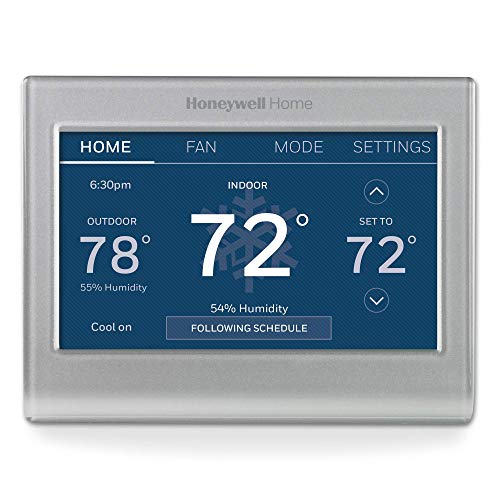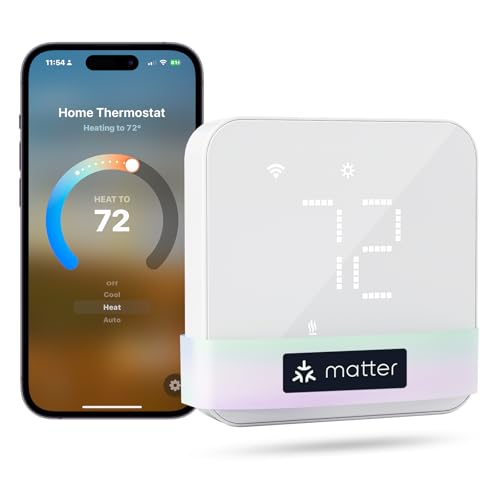If you’re looking to upgrade your home with smarter climate control, I recommend exploring the top 15 models for 2025. These include options like ecobee’s enhanced and premium thermostats, Sensi Touch, Google Nest, and Amazon’s budget-friendly smart thermostat. They offer features like voice control, energy savings, and compatibility with smart home systems. Keep going to discover which models best fit your home, budget, and tech preferences for a smarter, more efficient future.
Key Takeaways
- Compatibility with major voice assistants and smart home platforms enhances automation and control.
- ENERGY STAR certified models offer significant energy savings and eco-friendly operation.
- Sleek, modern designs with high-definition displays improve user experience and aesthetics.
- Support for multi-room sensors and zone control increases comfort and efficiency.
- Easy DIY installation with app-guided setup makes upgrading to smart thermostats accessible in 2025.
ecobee Smart Thermostat Essential, Wi-Fi Programmable Thermostat
If you’re looking for a budget-friendly yet feature-rich smart thermostat, the ecobee Smart Thermostat Essential is an excellent choice. It’s Energy Star certified, compatible with Siri, Alexa, Google Assistant, and Apple HomeKit, making integration seamless. It works with most 24 VAC HVAC systems, including gas, electric, and heat pumps. Installation is straightforward, with no C-wire needed if you use the optional Power Extender Kit. The sleek 2025-style design features an LCD touch display, and it offers energy savings of up to 23% annually. Control your home’s comfort remotely via the app or voice, enjoying auto-scheduling and real-time energy tracking.
Best For: homeowners seeking an affordable, easy-to-install smart thermostat compatible with multiple voice assistants and existing HVAC systems.
Pros:
- Energy Star certified with up to 23% annual savings on heating and cooling costs.
- Compatible with major smart home ecosystems like Siri, Alexa, Google Assistant, and Apple HomeKit.
- Easy DIY installation with no C-wire required when using the optional Power Extender Kit.
Cons:
- Some users experience a learning curve during initial setup and app navigation.
- Requires purchase of a separate cover plate for wall mounting, and minor drywall touch-up may be needed.
- Eco mode’s efficiency may vary depending on system and user settings.
Sensi Smart Thermostat
The Sensi Smart Thermostat stands out for homeowners seeking an easy-to-install, compatible device that delivers energy savings and robust remote control features. I appreciate its straightforward setup, with step-by-step app instructions and physical buttons, making installation accessible even without a C-wire. Its compatibility with major smart home platforms like Alexa, Google Assistant, and SmartThings ensures seamless integration. The thermostat’s Energy Star certification helps reduce HVAC costs by around 23%, thanks to flexible scheduling and remote management. Its large LED display, user-friendly interface, and smart maintenance alerts make it an excellent choice for those wanting convenience, energy savings, and peace of mind—all backed by a three-year warranty.
Best For: homeowners seeking an easy-to-install, energy-efficient smart thermostat compatible with major smart home platforms and without the need for complex wiring.
Pros:
- Easy DIY installation with step-by-step app guidance and physical buttons
- Compatible with Alexa, Google Assistant, SmartThings, and Vera for seamless smart home integration
- Energy Star certified, helping save approximately 23% on HVAC energy costs
Cons:
- Some older HVAC systems without C-wires may require external adapters for installation
- Initial instructions may suggest C-wire necessity, which isn’t always required, potentially causing confusion
- Limited to residential HVAC systems; may not be suitable for commercial or specialized HVAC setups
Amazon Smart Thermostat
The Amazon Smart Thermostat stands out as an excellent choice for homeowners seeking an easy and affordable upgrade to their heating and cooling systems. With Honeywell technology, it’s compatible with most 24V HVAC systems, like force air, heat pumps, and radiant boilers, though not with 110-240V setups. Setup is straightforward through the Alexa app, and it offers features like automatic adjustments, scheduling, and energy monitoring. Its sleek design and remote control via Alexa, voice, or Echo devices make managing your home’s climate simple. Certified ENERGY STAR, it can save you around $50 annually on energy bills, making it a smart, cost-effective upgrade.
Best For: homeowners seeking an affordable, easy-to-install smart thermostat compatible with most 24V HVAC systems and looking to reduce energy costs.
Pros:
- Simple setup via the Alexa app with guided installation
- Energy savings with ENERGY STAR certification and automatic adjustments
- Sleek design with remote control through Alexa, voice, and Echo devices
Cons:
- Not compatible with 110-240V systems like electric baseboards
- Potential network reconnection issues after power outages reported by some users
- Wiring complexity may require additional components such as a transformer or C-wire
ecobee Smart Thermostat Enhanced, Programmable Wi-Fi Thermostat
For homeowners seeking a reliable and energy-efficient smart thermostat, the ecobee Smart Thermostat Enhanced stands out with its automatic energy savings of up to 26% annually. It intelligently adjusts temperatures based on occupancy, sleep, and away modes, preheating or cooling your home before arrival. Compatible with most 24 VAC HVAC systems, it includes a Power Extender Kit for easy installation without a C-wire. The device features a responsive LCD display, app control, and integration with platforms like Apple HomeKit, Alexa, and Google Assistant. Its smart sensors and eco+ features optimize comfort and efficiency, making it a versatile, user-friendly choice for modern homes.
Best For: homeowners seeking an easy-to-install, energy-efficient smart thermostat compatible with various HVAC systems and integrated with popular smart home platforms.
Pros:
- Automates energy savings up to 26% annually by adjusting based on occupancy and schedules
- Compatible with most 24 VAC HVAC systems and includes a Power Extender Kit for easy installation without a C-wire
- Supports multiple smart home platforms like Apple HomeKit, Alexa, Google Assistant, and IFTTT for seamless integration
Cons:
- Initial setup may be challenging, especially for homes without a C-wire, potentially requiring professional help
- The auto-sensing display turns off when passing by, which can make quick glances inconvenient
- Repeated website logins can be frustrating for users needing frequent access to the app or account
ecobee Smart Thermostat Premium with Smart Sensor and Air Quality Monitor
If you’re looking to optimize your home’s comfort while saving energy, the ecobee Smart Thermostat Premium stands out thanks to its SmartSensor technology that targets hot and cold spots. It can cut heating and cooling costs by up to 26% annually and features an air quality monitor that alerts you to poor conditions, offering tips and filter change reminders. With occupancy sensing, geofencing, and smart alerts, it actively saves energy. Plus, it acts as a home monitoring hub with smoke detection and break-in alerts, especially when paired with ecobee Smart Security. Its sleek design and compatibility with various HVAC systems make it a versatile, smart choice for modern homes.
Best For: homeowners seeking to enhance energy efficiency, improve indoor air quality, and enjoy smart home integration with customizable comfort controls.
Pros:
- Significantly reduces heating and cooling costs by up to 26% annually, saving money over time
- Includes SmartSensor technology to eliminate hot and cold spots, enhancing overall comfort
- Acts as a comprehensive home hub with built-in air quality and smoke detection features
Cons:
- Installation can be complex and may require professional help, especially for older or unconventional HVAC systems
- Sensor setup and directions may be confusing or inconsistent, leading to potential frustration
- Compatibility with certain smart home hubs (like Apple HomeKit) may require additional accessories or subscriptions
RTH9585WF1004 Wi-Fi Smart Color Thermostat
Featuring customizable color options and a bright, easy-to-read touchscreen, the RTH9585WF1004 Wi-Fi Smart Color Thermostat stands out as an excellent choice for those who want to personalize their home’s appearance while enjoying intuitive control. Its 7-day programmable scheduling makes it easy to tailor your heating and cooling routines. The ENERGY STAR certification guarantees energy efficiency and potential cost savings through detailed reports and tips. It’s compatible with a variety of systems, including forced air and heat pumps, but requires a C-wire for installation. With Alexa-ready voice control and smart home integration, this thermostat combines style, convenience, and savings seamlessly.
Best For: homeowners seeking a customizable, energy-efficient smart thermostat with seamless smart home integration and easy scheduling.
Pros:
- Customizable color options to match home décor
- Bright, easy-to-read touchscreen for intuitive operation
- Supports 7-day programmable scheduling for tailored routines
Cons:
- Requires a C-wire for installation, which may not be available in all homes
- Not suitable for electric baseboard heating systems (120-240V)
- Compatibility limited to certain heating and cooling systems, so verification is necessary before purchase
Google Nest Thermostat, Programmable Wi-Fi Smart Thermostat
The Google Nest Thermostat stands out as an excellent choice for homeowners seeking energy savings and smart home integration. It features a sleek design with a 2-inch LCD display, supports remote control via the Google Home app, and works with voice commands. Easy to install in about 30 minutes, it’s compatible with various heating and cooling systems, often without needing a C wire. The thermostat learns your preferences, optimizes energy use, and offers savings tips and utility rebates. With reliable performance and user-friendly controls, it helps make your home smarter and more efficient, though initial setup can sometimes pose minor challenges.
Best For: homeowners looking to enhance energy efficiency and integrate a smart, programmable Wi-Fi thermostat easily into their existing heating and cooling systems.
Pros:
- Sleek, modern design with a user-friendly 2-inch LCD display.
- Easy DIY installation typically completed in under 30 minutes.
- Supports remote control, voice commands, and provides energy-saving tips and rebates.
Cons:
- Initial setup may involve wiring adjustments and calibration challenges.
- Connectivity issues can occur during internet outages, affecting functionality.
- Some users may require additional accessories like a C wire depending on their system type.
Sensi Lite Smart Thermostat
For homeowners seeking an affordable yet feature-rich smart thermostat, the Sensi Lite Smart Thermostat stands out as an excellent choice. It’s Wi-Fi-enabled, compatible with Alexa, and works with most HVAC systems—only needing a C-wire for heat pump and heat/cool setups. Certified by ENERGY STAR, it helps save about 23% on energy costs through flexible scheduling, geofencing, and remote access. Installation is straightforward with a built-in level and clear instructions, making DIY setup easy. Plus, its mobile app lets you control your home’s temperature from anywhere, offering convenience and peace of mind.
Best For: homeowners seeking an affordable, easy-to-install smart thermostat with energy-saving features and remote control capabilities.
Pros:
- Easy DIY installation with built-in level and clear instructions
- Compatible with most HVAC systems and Alexa for voice control
- Helps save approximately 23% on energy costs through flexible scheduling and geofencing
Cons:
- Requires a C-wire only for heat pump and heat/cool systems; some setups may need additional wiring
- Lacks advanced features found in higher-end smart thermostats
- Mobile app ratings may vary slightly between Android and iOS devices
EMERSON Sensi Touch Wi-Fi Smart Thermostat
Looking for a smart thermostat that combines sleek design with reliable performance? The Emerson Sensi Touch Wi-Fi Smart Thermostat (Model ST75W) fits the bill perfectly. Its vibrant touchscreen display, wall-mount design, and simple setup make it a standout. It supports voice commands and integrates with Alexa, Google Assistant, Apple HomeKit, and more. I appreciate its quick installation, even without a C-wire, and the user-friendly app that lets me control my HVAC remotely. With features like auto changeover, geofencing, and energy monitoring, it helps me save around 23% on energy bills while maintaining comfort. Overall, it’s a durable, dependable choice for smart home enthusiasts.
Best For: homeowners and smart home enthusiasts seeking a sleek, reliable, and energy-efficient Wi-Fi thermostat with easy installation and voice control.
Pros:
- Stylish touchscreen display and modern wall-mount design for an attractive look
- Easy installation with minimal wiring, even without a C-wire, and quick setup process
- Supports multiple smart home platforms (Alexa, Google Assistant, Apple HomeKit) for seamless integration
Cons:
- Some users may experience temperature calibration issues requiring support assistance
- Limited to 90% non-condensing humidity, which may not suit all environments
- Occasional software updates and bug fixes needed to maintain optimal performance
Like-New Amazon Smart Thermostat with Alexa Compatibility
If you want a smart thermostat that combines affordability with reliable performance, the Like-New Amazon Smart Thermostat with Alexa Compatibility is an excellent choice. It’s ENERGY STAR certified, refurbished, and tested to look and work like new, with the same limited warranty as a new device. Installation is DIY—just confirm you have a C-wire—and the Alexa app guides you through setup, with customer support available. It can save you around $50 annually on energy bills, and Amazon offers rebate info from local providers. With voice control and automation, you can easily adjust your home’s temperature remotely or create comfort zones using Echo devices.
Best For: homeowners seeking an affordable, reliable, and easy-to-install smart thermostat to enhance energy efficiency and remote control comfort.
Pros:
- ENERGY STAR certified, ensuring energy savings and environmental benefits
- DIY installation with clear Alexa app guidance and customer support
- Automates temperature adjustments based on presence detection or temperature readings
Cons:
- Requires a C-wire for installation, which may not be present in all homes
- Refurbished device may have minor cosmetic imperfections
- Limited to Amazon Alexa ecosystem, less compatible with other smart home platforms
RTH9600WF Smart Color Thermostat, Wi-Fi, Alexa Ready
The RTH9600WF Smart Color Thermostat stands out as an excellent choice for homeowners seeking a customizable and energy-efficient smart device. Its high-definition color display lets me personalize the interface, while real-time indoor and outdoor temperatures, humidity, and weather forecasts keep me informed. Being Wi-Fi enabled and Alexa compatible means I can control it remotely via an app or voice commands, adding convenience. It supports various heating systems, helping me reduce energy consumption with personalized tips and potential rebates. Just verify my home wiring includes a C-wire for installation. Overall, it’s a versatile, user-friendly thermostat that enhances comfort and efficiency in my home.
Best For: homeowners seeking a customizable, energy-efficient smart thermostat compatible with Wi-Fi and voice control for enhanced home comfort.
Pros:
- High-definition color display with customizable interface for personalized aesthetics
- Supports remote control via app and voice commands with Alexa, Google Assistant, and others
- Helps reduce energy costs through tracking, tips, and potential rebates
Cons:
- Requires a C-wire for installation; incompatible with homes lacking this wiring
- Does not support electric baseboard heating (120-240V) systems
- Installation may be complex for users unfamiliar with wiring or smart device setup
Emerson Sensi Touch Wi-Fi Smart Thermostat
The Emerson Sensi Touch Wi-Fi Smart Thermostat stands out for its intuitive 5.625 x 3.4-inch touchscreen color display, making it easy to navigate and control your home’s climate. I love how its sleek design and large display simplify programming and adjustments. Setup is straightforward with built-in level, illuminated terminals, and step-by-step app instructions. It’s compatible with most HVAC systems, though a c-wire is required. The thermostat helps reduce energy use by around 23%, and remote control via the Sensi app adds convenience. Plus, it offers smart maintenance alerts, performance monitoring, and flexible scheduling, making it a smart addition for any home.
Best For: homeowners seeking an easy-to-use, energy-efficient smart thermostat with remote access and a modern touchscreen display.
Pros:
- Intuitive 5.625 x 3.4-inch touchscreen color display simplifies control and programming
- Helps reduce HVAC energy consumption by approximately 23% for cost savings
- Supports remote management via the Sensi app for Android and iOS, offering convenience from anywhere
Cons:
- Requires a common (c-wire) for installation, which may not be present in all homes
- Limited color options, primarily available in black, white, and silver
- Compatibility depends on the HVAC system, so some setups may need additional components or may not be compatible
Sensi Touch 2 Smart Thermostat with Touchscreen
With its intuitive touchscreen color display and seamless Wi-Fi connectivity, the Sensi Touch 2 Smart Thermostat stands out as an excellent choice for homeowners seeking both convenience and advanced control. It’s compatible with Alexa and works with optional Sensi Room Sensors to balance temperatures throughout your home. Certified by ENERGY STAR, it can cut your HVAC energy use by about 23%, helping you save on utility bills. Installation is straightforward with its user-friendly app and step-by-step guidance. Plus, it monitors system performance, offering maintenance alerts and detailed usage reports—all while prioritizing your privacy and data security.
Best For: homeowners seeking an easy-to-install, energy-efficient smart thermostat with customizable controls and smart home integration.
Pros:
- Easy DIY installation with step-by-step app guidance
- ENERGY STAR certified, reducing HVAC energy use by approximately 23%
- Compatible with Alexa and optional Sensi Room Sensors for customized comfort
Cons:
- Requires a C-wire for installation, which may not be present in all homes
- Sensi Room Sensors are sold separately, adding to overall cost
- Limited advanced customization options compared to high-end smart thermostats
Google Nest Thermostat with Temperature Sensor (4th & 2nd Gen)
If you’re looking to optimize your home’s climate control with a sleek, easy-to-install smart thermostat, the Google Nest Thermostat with Temperature Sensor (4th & 2nd Gen) is an excellent choice. It features a larger display with Dynamic Farsight, so you can see information from across the room, and automatically adjusts brightness for clarity. Compatible with most 24V systems, it’s a straightforward DIY install that doesn’t require a C wire. Control is simple via the Google Home app, with voice options through Alexa, Siri, or Google Assistant. Plus, the included temperature sensor helps manage hot and cold spots, maximizing comfort and energy savings.
Best For: homeowners seeking an easy-to-install, stylish smart thermostat with advanced features to optimize comfort and energy savings.
Pros:
- Large display with Dynamic Farsight for easy readability from across the room
- No C wire needed, simplifying DIY installation on most 24V systems
- Compatible with Google Assistant, Alexa, and Siri for versatile voice control
Cons:
- May require app management for schedule adjustments, which could be less intuitive for some users
- Limited compatibility with non-24V heating and cooling systems
- The sensor placement requires manual setup in different rooms for optimal performance
meross Smart Thermostat for Home, WiFi Thermostat
For those seeking an affordable yet reliable smart thermostat, the meross Smart Thermostat (Model MTS300) stands out with its broad compatibility and sleek design. It supports 95% of HVAC systems, including traditional heating, cooling, and heat pumps, though it’s not compatible with electric baseboard heaters. Installation is straightforward, especially with the optional C-wire adapter if needed. The device connects to 2.4GHz Wi-Fi and integrates seamlessly with Alexa, Google Assistant, Apple HomeKit, and Samsung SmartThings. Users appreciate its easy setup, intuitive app control, and 7x24h scheduling. Overall, it’s an affordable, stylish, and reliable choice for smarter home climate management.
Best For: homeowners seeking an affordable, easy-to-install smart thermostat compatible with most HVAC systems and smart home platforms.
Pros:
- Supports a wide range of HVAC systems (95%), including heating, cooling, and heat pumps.
- Seamless integration with popular voice assistants and smart home protocols like Matter, Alexa, Google Assistant, Apple HomeKit, and Samsung SmartThings.
- User-friendly setup with a sleek, minimalist design and customizable scheduling features.
Cons:
- Not compatible with electric baseboard heaters.
- Requires a C-wire for installation; may need an adapter if not present.
- Limited fan control options, such as recirculation only during set periods, and no built-in geofencing.
Factors to Consider When Choosing Smart Thermostats

When choosing a smart thermostat, I consider how well it works with my HVAC system and how easy it is to install. I also look at how it integrates with my existing smart home devices, along with its energy-saving features. Finally, I prioritize a user-friendly interface that makes daily adjustments simple and intuitive.
Compatibility With HVAC Systems
Choosing a smart thermostat that works seamlessly with your HVAC system starts with verifying compatibility. First, check your system type—gas, electric, oil, heat pump, or boiler—and consult the manufacturer’s specifications to guarantee the thermostat supports it. Next, determine if your system needs a common wire (C-wire), as many smart thermostats rely on this for power. Confirm that the thermostat matches your system’s voltage and control signals, usually 24V for most homes. If you have multiple zones or a multi-stage system, ensure the thermostat can handle these complexities. Using compatibility tools or checklists from the manufacturer can save you time and prevent future issues. Proper compatibility is essential for smooth operation and reliable control.
Ease of Installation
Installing a smart thermostat can seem intimidating, but selecting a model with straightforward setup features can make the process much easier. Look for thermostats with clear, step-by-step instructions or app-guided installation to simplify setup. Check if the device requires a C-wire; models that don’t need one usually offer easier installation options. Built-in levels and wiring labels help ensure correct placement and connections, reducing mistakes. Consider whether the thermostat supports easy removal and reinstallation without damaging your drywall or needing extensive patching. Also, verify if the installation process is compatible with your existing HVAC wiring—some setups might require professional help for complex systems. Choosing a model with these features makes the installation smoother and less stressful.
Smart Home Integration
Integrating your smart thermostat into a broader home automation system can considerably enhance convenience and energy efficiency. To do this effectively, make sure it’s compatible with your existing ecosystems like Alexa, Google Assistant, Apple HomeKit, or Samsung SmartThings. Support for protocols such as Matter, Zigbee, or Z-Wave is vital for seamless connectivity with various devices. Check if the thermostat offers a dedicated app for remote control, so you can manage settings from anywhere. Voice assistant integration allows for hands-free adjustments and scheduling through simple commands. Additionally, compatibility with smart sensors and automation routines helps optimize comfort and energy use without manual intervention. Ensuring these features work together can make your smart home truly intuitive and efficient.
Energy Saving Features
Smart thermostats with energy-saving features can substantially cut your heating and cooling costs by intelligently adjusting settings based on your routines and occupancy. Look for models with adaptive scheduling and auto-adjustment, which optimize temperatures without you having to manually intervene. Support for geofencing is also essential; it can automatically lower or raise temperatures when your smartphone enters or leaves the house, preventing energy waste. Prioritize thermostats that offer energy consumption tracking and detailed reports, giving you insights into your usage patterns and ways to improve efficiency. Eco-friendly modes, like auto-away or sleep settings, automatically adjust temperatures during low-occupancy periods, saving energy without sacrificing comfort. Finally, real-time energy data and tips can help you identify habits that drive up bills, enabling smarter decisions over time.
User Interface Design
Choosing a smart thermostat isn’t just about its features; how you interact with it matters just as much. A user-friendly interface with a clear display and simple navigation makes setup quicker and daily use smoother. Touchscreens that respond well and offer customizable layouts allow you to tailor controls to your preferences. For those with limited dexterity or vision, large, tactile buttons or dials are essential, ensuring easy adjustments. Visual indicators like color coding, icons, and status lights help you instantly grasp system states and settings without confusion. A well-designed interface provides quick access to key features like scheduling, mode changes, and energy monitoring, reducing effort and frustration. Ultimately, a thoughtful interface enhances your experience and encourages consistent, suitable thermostat use.
Voice Control Capabilities
Voice control capabilities can substantially enhance how effortlessly you manage your home’s temperature, but it’s important to think about how well a thermostat works with your preferred voice assistant. Many smart thermostats support voice commands via Alexa, Google Assistant, or Siri, allowing you to change settings hands-free. This adds convenience, especially when your hands are full or you’re busy. The effectiveness of voice control depends on the device’s integration and quality of microphones and speakers. Some thermostats also let you create routines or scenes, triggering multiple actions with a simple command. Keep in mind that enabling these features usually requires a Wi-Fi connection and initial setup, like linking accounts or enabling skills. Choosing a thermostat with reliable voice control can make your smart home experience smoother and more intuitive.
Sensor and Automation Options
Sensor and automation options considerably boost a thermostat’s ability to maintain comfort and save energy. Room sensors that detect temperature and occupancy allow for more precise zoning, ensuring each area stays comfortable without wasting energy. Automated routines like auto-away or sleep modes adjust settings based on occupancy, time, or user preferences, optimizing energy use effortlessly. Some models support geofencing, which uses your phone’s location to automatically change heating or cooling when you arrive or leave. Additional sensors for humidity, air quality, or door and window status can enhance climate control and alert you to potential issues. Integration with automation platforms lets you create complex routines—like adjusting settings when specific sensors detect certain conditions—giving you better control over your home’s environment and efficiency.
Price and Rebate Opportunities
Price and rebate opportunities play a significant role in selecting a smart thermostat because they can substantially reduce the upfront cost and make the investment more affordable. Many ENERGY STAR-certified models qualify for rebates that offset purchase prices, which is a great way to save money. The initial cost varies widely, from budget options around $50 to premium models over $250. Utility companies often offer rebates or incentives for installing energy-efficient thermostats, further lowering the total expense. Additionally, manufacturers and third-party programs sometimes provide discounts or bundle deals, making these devices more accessible. Considering potential energy savings of up to 26% annually, investing in a smart thermostat can be cost-effective over time, especially when you take advantage of available rebates and incentives.
Frequently Asked Questions
How Do Smart Thermostats Improve Energy Efficiency Beyond Basic Scheduling?
Smart thermostats improve energy efficiency beyond basic scheduling by learning my daily routines and adjusting temperatures automatically. They use sensors and AI to detect when I’m home or away, optimizing heating and cooling accordingly. I love how they provide real-time energy usage data, so I can make smarter choices. Plus, some models even identify inefficient patterns, helping me save money while keeping my home comfortable.
Can Smart Thermostats Integrate With Existing Home Automation Systems?
Yes, smart thermostats easily integrate with existing home automation systems. I’ve connected mine with my smart lights and security cameras, allowing seamless control through a single app. Most models support popular platforms like Alexa, Google Home, and Apple HomeKit. This integration simplifies managing your home’s environment, enhances convenience, and can even automate routines, making your smart home truly responsive and personalized.
What Security Features Protect Smart Thermostats From Hacking?
Did you know that over 80% of smart device users worry about security? I make sure my smart thermostat has strong protections, like WPA3 encryption and secure Wi-Fi connections. Regular firmware updates are essential, too, as they patch vulnerabilities. I also enable two-factor authentication and change default passwords. These steps help prevent hacking and keep my home’s climate control safe and secure from cyber threats.
Are Smart Thermostats Suitable for Rental Properties or Temporary Setups?
Yes, smart thermostats are great for rental properties or temporary setups. I love how easy they are to install and remove without damaging the walls or existing systems. Plus, they offer remote control and scheduling, which is perfect for maintaining comfort and saving energy when you’re away. Just make certain the landlord approves, and you follow any specific installation guidelines. It’s a flexible, tech-savvy way to manage temperature easily.
How Does the Installation Process Vary Among Different Smart Thermostat Brands?
Installation processes for smart thermostats are like steering a maze—each brand has its twists. I’ve found that some, like Nest, offer straightforward, DIY-friendly setups with clear instructions. Others, like Ecobee, might require a bit more wiring knowledge or professional help. It’s wise to check compatibility and follow manufacturer guides. No matter the brand, patience and attention to detail make the process smoother.
Conclusion
Choosing the right smart thermostat can truly transform your home and your energy bills. As I’ve discovered, the perfect fit often comes down to small details—like a sensor or touchscreen—that seamlessly blend into daily life. I never expected that a simple upgrade would make such a difference, but it’s like finding a hidden gem in your own home. Sometimes, the best decisions happen when you least expect them, and your comfort is the reward.


























